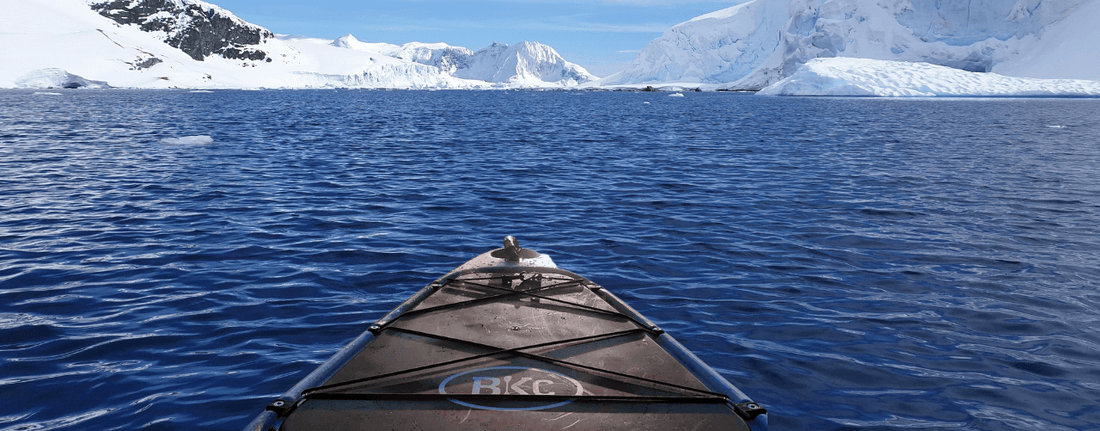Thinking about extending your kayaking season? Want to take advantage of beautiful fall days? Not afraid of a little cold? If you are thinking about doing some fall kayaking or winter kayaking, you may have heard about the 120°F Rule.
What is the 120°F Rule?
Simply put, the 120°F Rule says that if the combined temperature of the air + water = 120°F, then you are good to go on the water without additional cold weather protections (like a wet suit or dry suit or thermal protection).
This rule can be misleading. So let’s unpack it a bit and talk about tips for safe paddling in all kinds of weather.
Dangers of the 120°F Rule
For years the boating community has used this rule to determine when to break out the cold weather gear. But experts are sounding the alarm. In reality, the water temperature is the only guideline you really need. The air temperature doesn’t matter if you are submerged in 50 degree water.
Water temperature matters
If you use the 120-degree rule, you would assume that if the water temperature is 50 and the air is 75 (50+75=125), then you are at a safe kayaking temperature of 125 degrees and don’t need thermal protection.
However, the National Center for Cold Water Safety recommends caution when water is less than 70 degrees. If you fall into that 50-degree water that you thought meets the 120-degree requirement, you might be in trouble.
Water quickly conducts your body heat away from you. If water is 40 degrees or less, you have maybe 10 minutes before hypothermia sets in, and you risk unconsciousness. You might have only 3 minutes to perform a self-rescue before you begin to lose dexterity.
Even if the water warms to 50 degrees, your odds only increase slightly. You could have 30 minutes of consciousness and 5 minutes before loss of dexterity. At 60 degrees your chances of survival start to improve.
You are much more likely to survive at warmer temps, but anything under 70-degrees comes with risk.
False sense of security
This formula can give paddlers a false sense of security. Kayakers who assume that they won’t capsize or get wet are flirting with danger. You should also plan on getting wet (however unlikely or unexpectedly) when you are out on the water.
If you think that you are safe because the combined temperature is 120 degrees on a warm spring day but plunge into 45-degree water, you can risk cold water shock and the danger around it.
Inadequate preparation
When kayakers operate on a faulty premise, you may be less likely to prepare adequately. If you don’t dress for cold water immersion, it can have deadly consequences. You need to dress for the water temperature, not the air temperature.
Cold water dangers
Cold water immersion can contribute to a number of dangers. In water below 50 degrees, you risk hyperventilation from an involuntary gasp reflex. This could prevent you from self-rescuing or passing out.
Staying in the cold water could lead to cold incapacitation and even hypothermia. Your body temperature can drop to unsafe levels which can lead to death or injury.
Tips for Cold Water Paddling
- Life Jacket. Always, ALWAYS wear a personal flotation device. Even if you plunge into frigid water, it can provide buoyancy and keep you afloat until rescue arrives.
- Immersion Gear. Make sure that you have a well-fitted wet or dry suit. Prepare for the temperature and wear your gear even if the air temperature is balmy. If doesn’ help to have the suit WITH you, you must have it ON you.
- Base Layers. Under your thermal gear, you should wear moisture wicking layers for warmth and comfort.
- Footwear. Invest in some neoprene or other waterproof footwear that can offer protection and heat retaining.
- Self-rescue. Make sure you have a self-rescue plan in place. Practice these techniques frequently throughout the season so that they are second nature if you even need them. Muscle memory is terribly important in an emergency. Letting your honed instincts take over can save your life.
- Dry Clothes. If you do take an unexpected plunge, have some dry clothes available for when you return to land.
- Signaling Device. Having the appropriate safety equipment is also vital for cold-weather paddling. Ensure you have a signaling device, such as a flag, light, whistle, or flare that can alert others if you need help. Also, leave a float plan behind with someone who can send out help if you don’t arrive back on time.
Your kayak season doesn’t have to end when the temperatures drop. Just be smart. Dress appropriately for cold water, and remember that a warm day with cold water can still be a dangerous combination. Happy Paddling!

